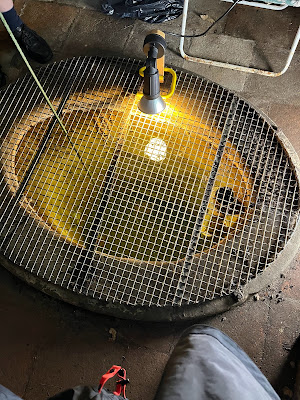The Margravina and I took an afternoon perambulation. Direct from the house, owing to the wines imbibed over a very nice lunch with my eldest sister and brother-in-law. Walking up Coombe Lane West, in the Coombe area of Kingston, we noticed the gate to Coombe Conduit was open. I mentioned this English Heritage property a couple of years ago on a walking blogpost. It is rarely open. So we popped in for the first time in two decades.
Here are a few snaps. Apologies for the misalignment of the first one. I only noticed when it was too late to do anything about. It should give you an idea though.
The site was staffed by members of the Kingston Society (a local conservation pressure group - I came away with good intentions of looking into this further). One of them explained that the ruined building was damaged indirectly by a bomb in the War. A tree was blown down by the explosion and it fell on the building, and wrecked it.
https://www.english-heritage.org.uk/visit/places/coombe-conduit/
Recent presentation regarding Coombe Conduit




I always find it instructive to see how ingenious our ancestors often were!
ReplyDeleteYes. When it comes to hygiene “history” tells us it’s all Romans and Victorians.
DeleteThat is a nice-looking little building - sometimes, old industrial buildings can have as much charm as a stately house or castle.
ReplyDeleteIt is isn’t it. I suppose tgis is one industrial building that helped a large stately house operate. I think at times there were 1,000 people in the household.
DeleteChris
Most interesting, thanks for sharing.
ReplyDeleteAlan/Tradgardland
I was very surprised the first time I came across it. There’s s primary school across the road where my older two kids went. The grounds there were often damp. It appears there are springs there too which were fed into Coombe Conduit.
DeleteChris
Ooh you do get about. So this was to collect water from various underground sources and channel it where required then? Lots to see in your neck of the woods isn’t there!
ReplyDeleteYeah. There's a layer of permeable stuff higher up the slope and part way down it hits an impermeable layer, so the water comes out in springs around that level. For semi-detached suburbia, there's quite a lot of historical stuff around.
DeleteNice old school industrial buildings!
ReplyDeleteBest Iain